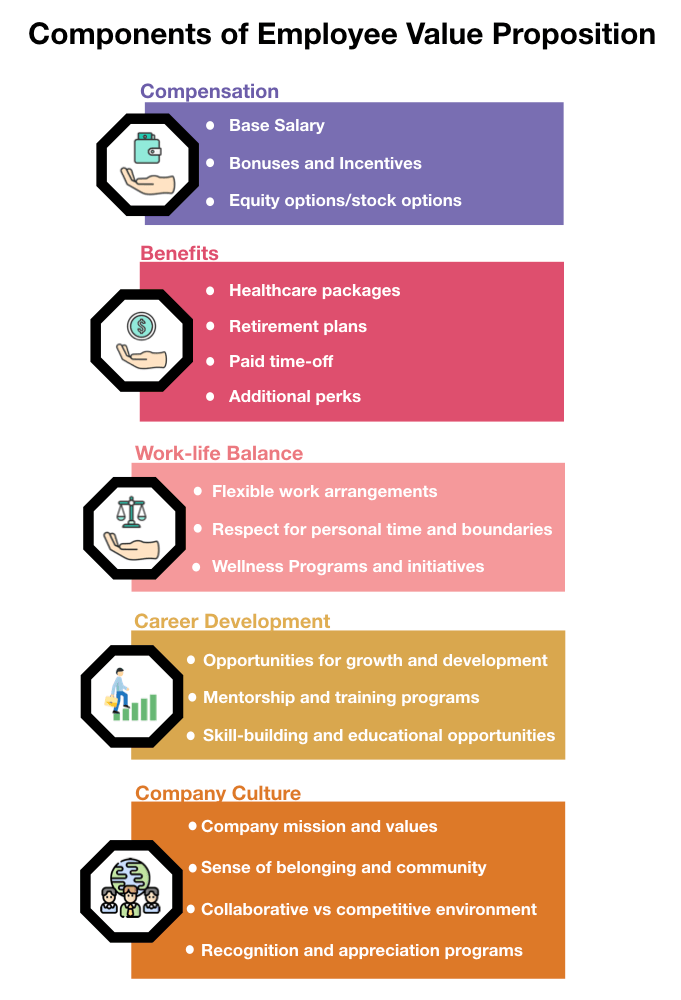How to Craft an Effective Employee Value Proposition
The concept of the Employee Value Proposition is swiftly garnering significance in organizations. Taking the lead in transforming workplaces, EVP is actively involved in attracting, engaging, and retaining top talent, simultaneously boosting the employer brand. To unlock its true potential, it is crucial to ensure that your EVP is relevant, distinctive, and captivating.
Having said that, you are probably brimming with curiosity about Employee Value Proposition and how you can leverage it to churn out the best results for you. This blog is particularly framed to help you properly grasp EVP and craft a strong EVP. Let us explore the details in the following section.
Key Takeaways
- What is Employee Value Proposition
- What are the components of Employee Value Proposition
- What are the benefits of Employee Value Proposition
- What are the tips on creating an EVP
- What are some Employee Value Proposition Examples
What is Employee Value Proposition?
An employee value proposition is a unique value you provide to your employees as employers in the shape of rewards for contributing their skills, experience, and commitment to your organization. Every employee brings forth unique experience, skills, and commitment to work.
You reward them with compensation, benefits, work-life balance, career development opportunities, and company culture. In short, you treat your employees as people, not just mere workers.
According to a study by Gartner, Organizations can reduce the compensation premium by 50% and reach 50% deeper into the labor market when candidates view their employee value proposition (EVP) as attractive.
An attractive employee value proposition sets these rewards, which clearly communicates the experience, benefits, and development people can expect from your company. The potential employees will assess whether their goals align with the company’s proposition and know if it’s the right place for them. It’s a way to attract, engage, and retain top performers in a competitive job market.
However, a strong employee value proposition goes beyond materialistic and tangible offerings. It encompasses the intangible benefits that differentiate your organization as an attractive and demanding workplace.
What are the components of Employee Value Proposition?
The significant components of an EVP are charted below for your smooth understanding.

Benefits of Employee Value Proposition
Having a compelling Employee Value Proposition comes with a plethora of benefits in the long run. Let us explore them in detail in the section below:
1. Attracting Top Talent

The better the quality of your EVP, the more it helps you differentiate yourself from your competitors. Highlighting the unique opportunities and benefits you propose is the optimal way to attract top performers who will fit your culture well.
2. Retention
As per Gartner’s study, businesses that effectively deliver on their EVP can decrease annual employee turnover by just under 70% and increase new hire commitment by nearly 30%
A strong EVP serves a larger purpose than simply attracting talent. It instills value and purpose in employees, making them stick with the company long-term. Having said that, retention is the surest possible way to reduce your recruitment and onboarding costs.
3. Engagement
When an EVP is shaped to align with employee values, it likely creates a surge of motivation among employees, steadily creating a satisfied workforce. Once the understanding of how their work contributes to the company’s goals seeps within them, they are likely to feel engaged and expand their productivity levels.
4. Employer Brand

A compelling EVP can potentially strengthen your company’s reputation as a suitable workplace. A positive employer brand plays a significant role in attracting qualified candidates as well as turning your present employees into brand ambassadors advocating for the brand’s success.
Tips on creating an EVP

Crafting a winning EVP does not happen overnight; it takes a step-by-step process to reach your desired result. This section will detail the steps and give you insight into capturing the essence while creating an attractive EVP.
According to Gartner’s report, 65% of potential candidates dropped out of a hiring process due to an unattractive EVP.
1. Research & Discovery
The first step is to engage in research and discovery. The points discussed in this section will give you a clear idea of the factors you must consider while researching.
-
Before building your EVP, the basic step is understanding your current situation. Conduct surveys to determine and understand employees' sentiments and what they value the most about working at your company.
-
Research and analyze your competitor’s EVP and employer branding. This process will help you identify their strengths and the potential gaps they leave that you can leverage to differentiate yourself.
-
You should know who you are striving to attract. Hence, try to understand your ideal candidates' demographics, skills, and values. Examine job boards and industry publications to analyze the qualities job seekers seek in an employer.
2. Identify Core Differentiators
The next step involves identifying crucial factors that help you differentiate yourself from the crowd.
-
Analyze your research and brainstorm to figure out what makes your company unique. Is it the emphasis on work-life balance, an innovative workspace, or commitment to social responsibility? Get this sorted.
-
You must involve your employees in getting their perspective about the company. Seek their responses on what makes the company special and why they enjoy working here.
-
Try to be honest with yourself. Refrain from presenting yourself as something you do not preach for. Instead, emphasize the genuine strengths of your company culture and offerings.
3. Craft Your EVP Statement
Crafting an EVP statement requires defining what you wish to deliver to your employees.
-
Make your EVP statement clear and concise, capturing the essence of your employee value proposition. Try to aim for something memorable and easy to communicate.
-
Focus on what your company offers employees, not just what you expect from them. Emphasize the benefits they will likely receive working for you.
-
You must ensure your EVP suitably aligns with the company’s core values. It should be a reflection of the overall culture and mission of your organization.
4. Promote your EVP
After crafting your EVP statement, you should ensure that you promote them vehemently. Things you should keep in mind for promotion:
-
Integrating your EVP into your employer branding across all channels, including social media, career websites, job postings, and recruitment materials, is essential.
-
You can turn your employees into your biggest advocates by internally communicating your EVP to ensure everyone understands and embodies it.
-
Also, incorporate your EVP throughout the recruitment process, from job descriptions to interview conversations. Showcase how your company adheres to delivering its value proposition.
5. Measure and Iterate
After you have done your part in creating and promoting your EVP, make sure you keep measuring and iterating.
-
Keep track of key metrics like employee engagement, retention rates, and time-to-time hires. You must see how your EVP impacts your talent acquisition and retention rates.
-
Gather regular feedback from employees and potential candidates. Track to what extent your EVP resonates with the target groups and identify areas for improvement.
-
You need to prepare yourself to adapt and refine your EVP based on the continuous research, feedback, and evolving talent landscape.
The process of effective EVP is a continuous loop. You need to evolve your EVP with each passing time and align them with the changing times and requirements.
Employee Value Proposition Examples
The examples listed below demonstrate the power of a strong EVP and how they have fetched their respective results. By communicating what makes your company special and how you value your employees, these companies have successfully positioned themselves as top employers among their competitors.
Trader Joe’s
As a renowned chain of grocery stores, Trader Joe’s has etched its name for its unique products and quirky atmosphere. In addition, Trader Joe’s boasts an excellent EVP. The primary focus is on the following:
- The company offers employees above-average pay, comprehensive health insurance, and generous retirement plans.
- It offers extensive training programs to assist crew members to advance their careers.
- It fosters a fun and supportive work environment that prioritizes employee well-being and teamwork.
As a result, Trader Joe’s consistently ranks high on “best places to work” and revels in low employee turnover. This allows them to attract and retain top talent in the long run.
HubSpot
As a marketing and sales software company, Hubspot takes pride in mastering the provision of work-life balance and employee well-being in their employee value proposition.
- It empowers employees to choose where to work by offering remote and hybrid work options.
- Its generous benefits package includes healthcare, parental leave, and wellness programs.
- It heavily invests in employee training and development, encouraging them to stay ahead of the competition.
In response, HubSpot attracts high-caliber talent who seek companies that value their well-being and professional growth. This results in a highly productive and engaged workforce.
Zappos
The online shoe retailer Zappos is renowned for its company culture, which is a significant element of its EVP. The primary focus is on the following:
- It prioritizes employee happiness, which helps them create a fun and collaborative work environment.
- It offers benefits beyond traditional healthcare, covering wellness programs and tuition reimbursement.
- The company empowers its employees to make decisions and take ownership of their work.
As a result, Zappos has nailed the art of attracting passionate and creative employees who thrive in its unique culture. This has led to higher employee satisfaction and loyalty, making employees stay with the company longer.
Conclusion
Employee Value Proposition is one powerful tool that can bring wonders to your company. You must continuously refine your EVP, attuning to evolving trends and demands. Unleashing the true power of EVP can help you attract, engage, and retain top talent for your organization.
Now, it is your turn to make the most of the EVP by crafting a compelling one.
FAQs
What are some common pitfalls to avoid when developing an EVP?
Avoid making promises that you cannot deliver on, such as unrealistic career advancement opportunities or misleading benefits. Ensure that your EVP accurately reflects the employees’ experience and aligns with your organization's values and culture.
How can I align our EVP with our employer brand?
Your EVP should reflect the unique characteristics and values of your employer brand. Ensure that the messaging, tone, and visuals used to communicate your EVP are consistent with your brand identity and positioning in the market.

















